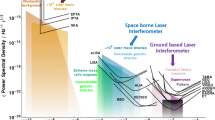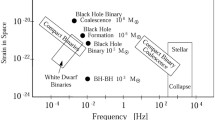Abstract
We discuss the possibility of detection of low-frequency gravitational waves by means of Doppler tracking of a relatively close satellite of the Earth. A detailed analysis is performed of electromagnetic fluctuations in the space communication channel and of the instrumental noise of receiving–transmitting systems. It is shown that when certain compensating procedures are used, one can detect gravitational radiation generated in star collapses and coalescences of binaries in our Galaxy in the frequency range from 2 × 10–3 to 5 × 10–1 Hz and with a metric variation amplitude of 10–15 and higher.
Similar content being viewed by others
REFERENCES
Anderson, A.J., Probability of Long Period Gravitational Radiation, Nature, 1971, vol. 229, pp. 547–550.
Anderson, A.J., Detection of Gravitational Waves by Spacecraft Doppler Data, Proc. of the Intern. Meeting on Experimental Gravitation, Pavia, Sept. 17-20, 1976, pp. 235–244.
Bertotti, B., Ambrosini, R., Asmar, S.W., et al., The Gravitational Wave Experiment, Astron. Astrophys. Suppl. Ser., 1992, vol. 92, pp. 431–441.
Bertotti, B., Comoretto, G., and Iess, L., Doppler Tracking of Spacecraft with Multi-Frequency Links, Astron. Astrophys., 1993, vol. 269, pp. 608–618.
Bertotti, B., Ambrosini, R., Armstrong, J.W., et al., Search for Gravitational Wave Trains with the Spacecraft ULISSES, Astron. Astrophys., 1995, vol. 296, pp. 13–25.
Tinto, M., Spacecraft Doppler Tracking as a Xylophone Detector of Gravitational Radiation, Phys. Rev. D: Part. Fields,1996, vol. 53, pp. 5354–5364.
Estabrook, F.B. and Walquist, H.D., Response of Doppler Spacecraft Tracking to Gravitational Radiation, Gen. Rel. Gravitation, 1975, vol. 6, pp. 439–447.
Rudenko, V.N. and Sazhin, M.V., Laser Interferometer as a Detector of Gravitational Waves, Kvant. Elektron., 1980, vol. 7, p. 2344.
Kardashev, N.S., Radioastron-a Radio Telescope Much Greater than the Earth, Exp. Astron., 1997, vol. 7, pp. 329–343.
Hils, D. and Bender, P.L., Gradual Approach to Coalescence for Compact Stars Orbiting Massive Black Holes, Astrophys. J., 1995, vol. 445, pp. 7–10.
Ivanov, P.B., On Formation Rate of Close Binaries Consisting of a Super-Massive Black Hole and a White Dwarf, ArXiv: astro-ph/0112317.
Haehnelt, M.G., Low-Frequency Gravitational Waves from Supermassive Black Holes, Mon. Not. R. Astron. Soc., 1994, vol. 269, pp. 199–208.
Author information
Authors and Affiliations
Rights and permissions
About this article
Cite this article
Kulagin, V.V., Kochetkova, A.Y., Rudenko, V.N. et al. Doppler Detection of Gravitational Bursts Using the Earth's Satellites. Cosmic Research 42, 13–18 (2004). https://doi.org/10.1023/B:COSM.0000017556.62100.a5
Issue Date:
DOI: https://doi.org/10.1023/B:COSM.0000017556.62100.a5




